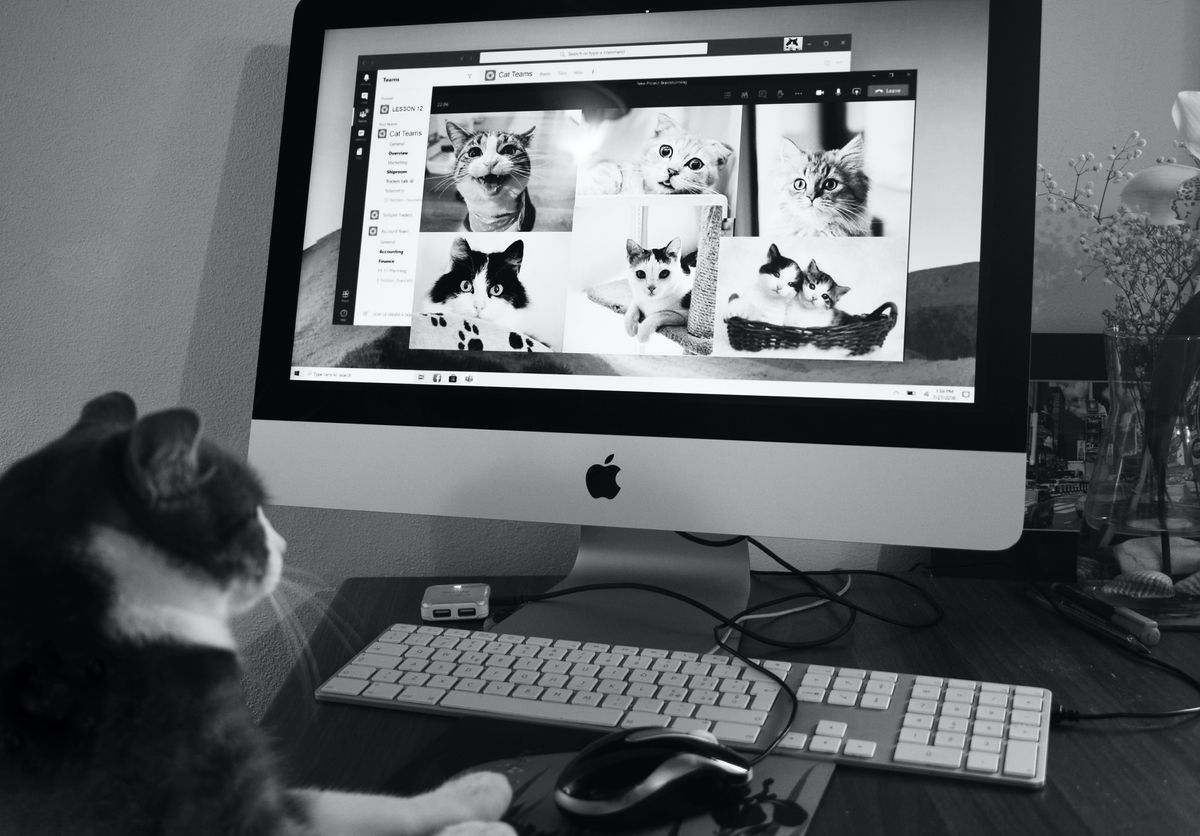How to Set Boundaries When You Work From Home
Working from home can blur the boundaries between work and everything else. Learn 5 strategies to set those boundaries!

One of the silver linings of the pandemic has been the culture shift to allow for full-time work-from-home (WFH) or hybrid arrangements where you only go into the office part-time.
The traditional 8-to-5 of being chained to your desk is becoming less common for many of us, replaced by more flexible options. In fact, the newer generations of office workers might not accept the more traditional setups anymore, as evidenced by what's been called, the Great Resignation. Employers are more likely to attract and retain more people if they are willing to offer different working arrangements for their teams.
That said, flexible work arrangements and working from home come with their own challenges, the biggest one being:
The blurring of boundaries between work time and…everything else.
People are working MORE when they work from home
When the pandemic hit, many organizations scrambled to get their teams set up to work from home, and there wasn’t a lot of thoughtful planning put into the transition. People set up at home haphazardly and many have been working that way ever since.
Though it’s been nearly 2 years since the initial shift and some teams have returned to the office with hybrid arrangements, a lot of people continue to work from home. Those people who are working from home are working on average 3 hours more per week than when they worked in the office. [1]
Some of this is because of the elimination of commutes and changes in personal grooming (sweat pants for the win!), but not all: most of it is work hours bleeding into other parts of your life!

Why working from home blurs the boundaries of work and your personal life
There are several reasons why it’s so easy to blur the boundaries of work and home:
1. There is no physical change from work to home or home to work
Usually, the context change between work and home signals the beginning and end of work. But when you work from home, there are no clear breakpoints of a commute to and from the office. It’s easy for the time to blend with your home routines.
2. Setting time boundaries is hard
Even when working in an office, most people are not good at setting time boundaries. They get booked for meetings at any time, check their emails constantly, allow themselves to be interrupted by instant messages and colleagues popping in randomly, and jump from fire to fire instead of planning out their days and week.
It’s easier to be passive than it is to set boundaries.
When you work from home, it’s even easier to:
- Let your work hours slip a little more and more into your home time.
- Be distracted by work-related things when you are supposed to be engaged with your family or friends.
- Sneak in some email or project work in the evening or on the weekends, just to “stay on top of things” because your laptop is RIGHT there.
These are often passive occurrences that happen without a ton of thought about the consequences. They are reactive and, in the short term, seem like no big deal. But over time, they become the norm. Suddenly you realize you are working all the time and neglecting the other important parts of your life.
3. Many employers haven’t set clear work-from-home expectations
The expectations for what is acceptable when you work from home versus in the office are different in many ways and they need to be stated clearly by your leadership. If it’s not defined, it’s easy to feel uncertain and anxious about when work stops and home-time begins, and what’s allowed/not allowed.
There is often a strong sense of obligation to work, which isn’t necessarily matched to the expectations of your employer. That said, no one wants to feel like they are sneaking around behind their employer's back to drive the kids to school or go for a post-lunch walk.
5 strategies to set boundaries when you work from home
When you work from home, it’s even more important for you to set clear boundaries between work time and everything else so you aren’t working all the time.
Here are 5 strategies:
- Have a dedicated physical workspace in your home
- Establish beginning and end-of-day rituals
- Map your ideal week in your calendar and use it to plan your week
- Time block breaks/recharge time into everyday
- Talk to your boss and team about work-from-home expectations
1. Have a dedicated physical workspace in your home
This might seem obvious but many people are still working from folding tables or a laptop on the couch. Having a dedicated physical workspace sets a clear context for your work environment versus your home environment.
Take the time to set yourself up to have a nice space that is quiet, clean, and has all the tools you need to work comfortably from home. This becomes a cue for your brain and body that it is work time and will help you get in the mental space to work.

2. Establish beginning and end-of-day rituals
The beginning and end of the day used to be set because you would have to commute home. You would have the time on the way home to transition from thinking about home to work and vice versa. When you work from home, the beginning and end of the day can be fairly fluid and it is harder to make the transition.
Ritual is a powerful way to tell your brain and body when it is time to shift context.
For example, a beginning of the workday ritual might be:
- 15 minutes of yoga
- Pour a cup of coffee and a glass of water
- Sit at your desk and put on your noise-cancelling headphones
- Turn on your computer and log into your work apps
- Triage your email for 15 minutes
- Start your morning work
An end of day ritual might be:
- Make a list of the 3-5 items that need your attention tomorrow
- Close all of your work apps
- Take off your headphones and turn off your computer
- Tidy your desk
- Go for a 15-minute walk
What steps could you establish to create your beginning and end-of-day rituals?
3. Map your ideal week in your calendar and use it to plan your week
It’s easier to set time boundaries when you can visualize where your time is going.
Mapping your ideal week (both personal and professional) is a way to get clarity on your normal daily routines and commitments and visualize the space you ACTUALLY have in your days for different priorities. You can read an entire post on it, but the gist is:
- Brainstorm the top activities that you ACTUALLY spend time on (daily routines, recurring meetings etc.).
- Brainstorm the top activities that you WANT to spend time on (fitness, date night, learning, etc.).
- Map it out by hand, in a spreadsheet, or create a separate calendar.
- Use your ideal week as a template to plan future weeks.
While your actual week will not match your ideal week perfectly, mapping your ideal week and referencing it regularly will help you make decisions about the commitments you make and remind you to keep boundaries around them.
4. Time block breaks/recharge time into everyday
When you work in an office, there tend to be more clear breaks and opportunities for time away from your desk. Your work colleagues might pop in for a coffee break or go for lunch together.
When you work from home, you don’t have these social cues to break up the day so you have to make them up for yourself AND protect them.
- Block off lunchtime for yourself every day and actually take it. Your body needs fuel and skipping lunch will always backfire in the form of less energy and motivation.
- Get up from your desk once an hour and move. Our bodies are not meant to sit for that long and there’s no water cooler chat to get you up at home.
- Add some other movement to your day. Go for a walk, do 15 minutes of yoga, and/or get a snack and a glass of water.

5. Talk to your boss and team about work-from-home expectations
A lot of anxiety and guilt are avoided when you know the expectations and ground rules for a work-from-home setup.
- What are the response time expectations for things like email and instant message apps like Slack or Teams?
- Do you need to check my email outside of work time?
- Is the team hours focused or outcome focussed? As in, can you step away from your desk to pick your kid up from school, while still taking care of your daily priorities, and have that be ok?
- How should you communicate with your manager and team members about projects and work progress?
- How can your team minimize interruptions, while still staying connected?
There are all kinds of questions that you can ask to find out what is acceptable and what isn’t for your work-from-home situation so you don’t feel anxious or uncertain and end up overworking. Ask! Talk to your boss and team and find out what the expectations are.
To set boundaries between work and home requires acknowledging that you have more power over your days than you think. While you can’t necessarily control every part of your day, you can be intentional about the things you do have control over to make it easier to set and keep those boundaries.
Need some help learning how to set your work-from-home boundaries? I can help!
Share
Ashley Janssen

Productivity consultant, writer, speaker, serial entrepreneur, chaos calmer, introvert, cat-lady. Lover of books, fitness, old fashioned’s, basketball, and video games.
Follow me on
Twitter
or
LinkedIn.
Hire me for
1 on 1 productivity consulting
or
speaking.
Related articles

8 Signs You Are A People Pleaser (And How To Stop!)

4 Ways to Reconnect to Your Habits and Reset Your Boundaries When They Slip


Comments ()